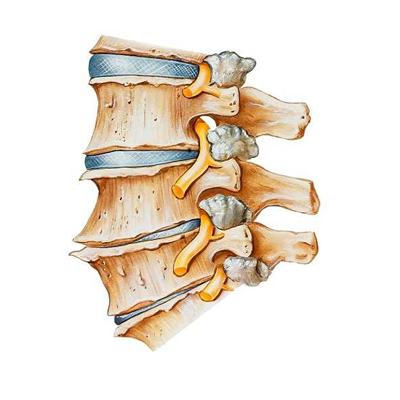Lumbar Spine Physiotherapy

What Is Lumbar Spondylosis?
Lumbar spondylosis is a general term used to describe the degenerative condition of the spine in the lower back. The purpose of the lumbar spine is to support most of the body’s weight. Hence it is natural that the vertebrae gradually get worn down and compressed due to wear and tear over time. Treatment of the condition predominantly involves pain relief through physiotherapy.
Degeneration of the spine may result in bone spur formation, disc degeneration or herniation. Spondylosis is more prevalent in the lumbar region than in the cervical as it withstands most of the mechanical stress. It is mostly common in people above the age of 60, and is more prevalent in women than men.
Signs & Symptoms Of Lumbar Spondylosis
It is normal that most people with this condition do not display any symptoms. However, when symptoms do occur, they usually include:
- Back pain and stiffness
- Pain after prolonged inactivity (eg: prolonged sitting, getting up from bed)
- Leg pain
- Numbness, tingling or weakness down the buttock and leg
The affected areas vary depending on the level of the nerve being irritated and compressed.
Treatment Of Lumbar Spondylosis
There is no treatment to reverse the process of spondylosis as it is a degenerative condition. However, means can be taken to relieve the symptoms, which include:
- Pain medication
- Lumbar spine physiotherapy
- Exercises
- Steroid Injections
- Surgery
Many with lumbar spondylosis may experience mild, occasional symptoms that require no treatment. However, if pain becomes persistent or severe, it is vital to seek medical attention as it could lead to other complications in the spinal region. Our team of physiotherapists at Rapid Physiocare can help you diagnose conditions of the lumbar spine and prescribe a suitable treatment and pain management plan for you. Book an appointment with us today.
Frequently Asked Questions
What is lumbar physical therapy?
Lumbar physiotherapy is a targeted rehab program for the lower back that reduces pain, restores movement, and strengthens the muscles that support the spine. A physiotherapist will assess your posture and movement, teach pain-relieving techniques (heat/soft tissue work, gentle hands-on care), and provide a personalised exercise plan to improve flexibility, core strength and function.
What is the best treatment for lumbar?
There’s no single “best” fix — the most effective approach combines:
- Guided physiotherapy and exercise to build strength and mobility,
- Activity modification (better posture, avoid prolonged sitting),
- Short-term pain control (ice/heat, medications as advised), and
- Further options (surgery) only when conservative care fails.
Begin with physiotherapy and a simple daily movement routine that benefits most people.
What is the best sleeping position for lumbar pain?
Two helpful positions:
- On your back with a pillow under your knees (or a small rolled towel under the lower back) to keep the lumbar curve supported.
- On your side with knees slightly bent and a pillow between your knees to keep hips and spine aligned.
Avoid sleeping on your stomach it twists the spine and strains the neck. Small pillow tweaks can make a big difference in morning pain.
How can I treat my lumbar spine at home?
Do these simple, safe steps daily:
- Move regularly: short walks and gentle movement every hour if you sit a lot.
- Gentle exercises: pelvic tilts, knee-rolls, straight-leg raises and core activations (do little and often).
- Stretch tight areas (hamstrings, hip flexors, calves).
- Use heat for stiffness and ice for acute flare-ups, and keep weight in a healthy range to reduce load. If pain or numbness gets worse, seek help from a professional.
What are the side effects of lumbar spine (problems)?
“Side effects” of lumbar degeneration or injury are basically the problems it can cause:
- Local back pain and stiffness, worse after sitting or on standing from rest.
- Radiating leg pain, numbness or weakness if a nerve is pinched (sciatica).
In severe cases, loss of bladder/bowel control or marked leg weakness these need urgent medical attention. Timely physio and assessment reduce the risk of longer-term problems.
What are the best sleeping positions for lumbar pain?
- Back sleeper: pillow under knees; small lumbar roll if you need more support.
- Side sleeper: pillow between knees; keep hips stacked.
- Choose a mattress that supports your body (medium-firm for many people) and avoid stomach sleeping. Try the position that lets you wake with the least pain.
Who needs lumbar support?
Lumbar support can help these people:
- Office workers and drivers who sit long hours,
- People with chronic low back pain or reduced core strength,
- Those doing heavy lifting or repetitive bending, and
Post-operative patients while recovering (as advised by a clinician).
A simple lumbar roll (towel or small cushion) placed at the small of the back can maintain spinal curve and reduce strain but it should complement, not replace, exercise and movement.

